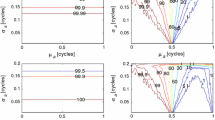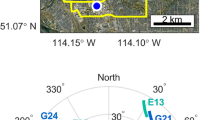Abstract
Integrity monitoring for ambiguity resolution is of significance for utilizing the high-precision carrier phase differential positioning for safety–critical navigational applications. The integer bootstrap estimator can provide an analytical probability density function, which enables the precise evaluation of the integrity risk for ambiguity validation. In order to monitor the effect of unknown ambiguity bias on the integer bootstrap estimator, the position-domain integrity risk of the integer bootstrapped baseline is evaluated under the complete failure modes by using the worst-case protection principle. Furthermore, a partial ambiguity resolution method is developed in order to satisfy the predefined integrity risk requirement. Static and kinematic experiments are carried out to test the proposed method by comparing with the traditional ratio test method and the protection level-based method. The static experimental result has shown that the proposed method can achieve a significant global availability improvement by 51% at most. The kinematic result reveals that the proposed method obtains the best balance between the positioning accuracy and the continuity performance.







Similar content being viewed by others
Explore related subjects
Discover the latest articles, news and stories from top researchers in related subjects.References
Blanch J, Walter T, Enge P (2010) RAIM with optimal integrity and continuity allocations under multiple failures. IEEE T Aerosp Electron Syst 46(3):1235–1247
De Jonge P, Tiberius C (1996) The LAMBDA method for integer ambiguity estimation: implementation aspects. No. 12 of LGR-Series. Delft Geodetic Computing Centre, Delft
Farrell JA, Givargis TD, Barth MJ (2000) Real-time differential carrier phase GPS-aided INS. IEEE Trans Control Syst Technol 8(4):709–721
Feng S, Ochieng W, Moore T, Hill C, Hide C (2009) Carrier-phase based integrity monitoring for high accuracy positioning. GPS Solut 13(1):13–22
ICAO Annex 10, Aeronautical Telecommunications, Volume 1 (Radio Navigation Aids), Amendment 84, published 20 July 2009, effective 19 November 2009. GNSS standards and recommended practices (SARPs) are contained in Section 3.7 and subsections, Appendix B, and Attachment D
Khanafesh S, Pervan B (2010) New approach for calculating position domain integrity risk for cycle resolution in carrier phase navigation systems. IEEE Trans Aerosp Electron Syst 46(1):296–307
Khanafseh S, Pervan B (2011) Detection and mitigation of reference receiver faults in differential carrier phase navigation systems. IEEE Trans Aerosp Electron Syst 47(4):2391–2404
Langel S, Khanafesh S, Pervan B (2016) Bounding the integer bootstrapped GNSS baseline’s tail probability in the presence of stochastic uncertainty. J Geod 90(11):1293–1305
Leick A, Rapoport L, Tatarnikov D (2015) GPS satellite surveying, 4th edn. Wiley, New York
Li L, Quddus M, Ison S, Zhao L (2012) Multiple reference consistency check for LAAS: a novel position domain approach. GPS Solut 16(2):209–220
Li L, Quddus M, Zhao L (2013) High accuracy tightly-coupled integrity monitoring algorithm for map-matching. Transp Res C Emerg 36C:13–26
Li B, Shen Y, Feng Y, Gao W, Yang L (2014) GNSS ambiguity resolution with controllable failure rate for long baseline network RTK. J Geod 88(2):99–112
Li L, Li Z, Yuan H, Wang L, Hou Y (2016) Integrity monitoring-based ratio test for GNSS integer ambiguity validation. GPS Solut 20(3):573–585
Li L, Jia C, Zhao L, Yang F, Li Z (2017a) Integrity monitoring-based ambiguity validation for triple-carrier ambiguity resolution. GPS Solut 21(2):797–810
Li L, Wang H, Jia C, Zhao L, Zhao Y (2017b) Integrity and continuity allocation for the RAIM with multiple constellations. GPS Solut 21(4):1503–1513
Ochieng W, Sauer K, Walsh D, Brodin G, Griffin S, Denny M (2003) GPS integrity and potential impact on aviation safety. J Navig 56(1):51–65
Odijk D, Teunissen PJG (2008) ADOP in closed form for a hierarchy of multi-frequency single-baseline GNSS models. J Geod 82(8):473–492
Oehler V, Luongo F, Trautenberg HL, Boyero J-P, Krueger J, Rang T (2005) The Galileo integrity concept and performance. In: Proceedings of ION GNSS 2005, Institute of Navigation, Fort Worth, pp 604–615
Parkins A (2011) Increasing GNSS RTK availability with a new single-epoch batch partial ambiguity resolution algorithm. GPS Solut 15(4):391–402
Parkinson B, Spilker J, Axelrad P, Enge P (1996) Global positioning system: theory and applications, vol II. American Institute of Aeronautics and Astronautics Inc, Washington
Teunissen PJG (1998) Success probability of integer GPS ambiguity rounding and bootstrapping. J Geod 72(10):606–612
Teunissen PJG (1999) An optimality property of the integer least-squares estimator. J Geod 73(11):587–593
Teunissen PJG (2001) The probability distribution of the ambiguity bootstrapped GNSS baseline. J Geod 75(5–6):267–275
Teunissen PJG (2004) Penalized GNSS ambiguity resolution. J Geod 78(4):235–244
Teunissen PJG, Verhagen S (2009) The GNSS ambiguity ratio-test revisited: a better way of using it. Surv Rev 41(312):138–151
Wang L, Verhagen S (2014) A new ambiguity acceptance test threshold determination method with controllable failure rate. J Geod 89(4):361–375
Acknowledgements
The authors thank Dr. Gang Liu from Naval Aeronautical and Astronautical University (China) for providing the kinematic GNSS data. This research was jointly funded by National Natural Science Foundation of China (Nos. 61773132, 61633008, 61374007, 61304235), the Fundamental Research Funds for Central Universities (No. HEUCFP201768), and the Post-Doctoral Scientific Research Foundation, Heilongjiang Province (No. LBH-Q15033).
Author information
Authors and Affiliations
Corresponding author
Appendix: bounding the ambiguity bias
Appendix: bounding the ambiguity bias
Since P(H1) + P(H0) = 1, thus,
Let us define Δb i,j = \({\mathbf{l}}_{j}^{T} \Delta {\mathbf{z}}_{i}\) to be the bias under the ith ambiguity resolution failure mode. Because any single failure rate of ambiguity resolution in (11) should be no less than 1 − P(H0),
Because the left-hand terms in (12) are monotonous with Δbj,i, the threshold value Δb th can be obtained iteratively by applying the Newton–Raphson method to (12), which yields,
According to the Cauchy–Schwartz inequality, the bias Δbj,i in (13) should satisfy
where lj,min and lj,max are the minimum and the maximum element of L j , Δzmin and Δzmax are the lower and upper bounds for ith failure mode, respectively. According to (14), in order to maintain the satisfaction of (13), the bias value should satisfy
in which abs[•] indicates the rounding operation and the absolute value sequentially. From (15), the lower and upper bounds of ambiguity bias as well as the searching space of ambiguity bias can be determined. It is noted that the searching space of ambiguity bias can be reduced when the success rate is higher.
Rights and permissions
About this article
Cite this article
Li, L., Shi, H., Jia, C. et al. Position-domain integrity risk-based ambiguity validation for the integer bootstrap estimator. GPS Solut 22, 39 (2018). https://doi.org/10.1007/s10291-018-0703-4
Received:
Accepted:
Published:
DOI: https://doi.org/10.1007/s10291-018-0703-4




